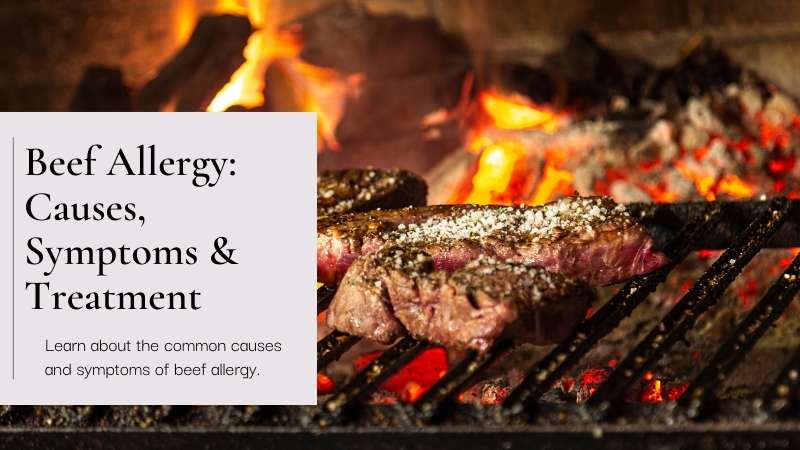Several people often suffer from some allergy or the other. They may react to something in the air, such as pollen or perfume. Some are also allergic to certain pets. Similarly, some suffer from certain food allergies. Over the past two decades, red meat has emerged as a significant food allergen. It is better to know beef allergy symptoms and then avoid it altogether.
A beef allergy occurs due to certain proteins prevalent in the beef. It is a serious health condition and must not be neglected. Those who are allergic to dairy products or suffer from dairy allergies are also prone to beef allergies.
Beef is used in many dishes in the West, although in some parts of the East, eating it is prohibited on religious grounds, as cow is considered a sacred animal. This is so in India. In the West, of course, people relish dishes made up of beef.

Beef meat is one of the growing food allergens. There are 3 types of Red meat allergens – [1]
- Primary beef allergy
- Pork-cat syndrome
- α-Gal syndrome
Adults with no prior allergies can develop α-Gal syndrome. Identifying symptom checks and tests is important for accurate diagnosis and research.
Symptoms of beef allergy
Some of the top beef allergy symptoms includes: [1] [2]
- Nausea
- Vomiting
- Urticaria
- Anaphylaxis
- Abdominal cramping
- Pruritus
- Rash
- Diarrhea
- Gastroesophageal reflux
Allergens of Beef allergy
Some of the primary Allergens are –
The allergenic proteins in beef are identified with molecular masses of:
- Approximately 200 kDa
- Approximately 67 kDa
- Approximately 60 kDa
The protein of approximately 67 kDa is Bovine serum albumin (BSA). 200 kDa and 60 kDa are glycoproteins. [3]
Beef allergy can cause very severe allergic reactions, often resulting in anaphylaxis. The latter is a severe allergic reaction requiring emergency treatment at a hospital.
What kind of tests and treatments are there for beef allergy?
- Heat treatment or freeze-drying can reduce beef’s allergenic properties. [4]
- One must avoid eating beef.
- While eating out, choose the dishes that do not contain beef.
- Cross contamination must not be there while cooking at home.
- One must keep a self- injecting epinephrine.
- In case one experiences any of the above-mentioned symptom then one must consult your physician.
Knowing how to ascertain that one is suffering from beef allergy is important. The following methods answer the query:
Detection test
- Skin prick tests might not identify IgE-mediated beef sensitization accurately. [5]
- Screening for beef-specific IgE antibodies is the correct test for the allergy.
- Oral food challenge is also effective in confirming the diagnosis.
Beef lovers enjoy the dishes that contain beef. In the US, hamburgers are very popular. Naturally, those suffering from beef allergy are missing out as they cannot eat beef-containing foods.
References
- Division of Allergy and Immunology, University of Virginia, Charlottesville, VA, 22908 – https://www.ncbi.nlm.nih.gov/pmc/articles/PMC6488443/
- Department of Pediatrics, University of North Carolina Food Allergy Initiative, Division of Allergy and Immunology, University of North Carolina School of Medicine, Chapel Hill, NC, USA – https://www.ncbi.nlm.nih.gov/pmc/articles/PMC8928418/
- Doctor’s Program in Functional Biology, Graduate School of Science and Technology, University of Niigata, Japan. – https://pubmed.ncbi.nlm.nih.gov/11055392/
- Division of Allergy and Immunology, University of Virginia, Charlottesville, VA, 22908 – https://pubmed.ncbi.nlm.nih.gov/11055392/
- Hacettepe University Faculty of Medicine, Department of Pediatric Allergy and Asthma, Ankara, Turkey. – https://pubmed.ncbi.nlm.nih.gov/12622743/
